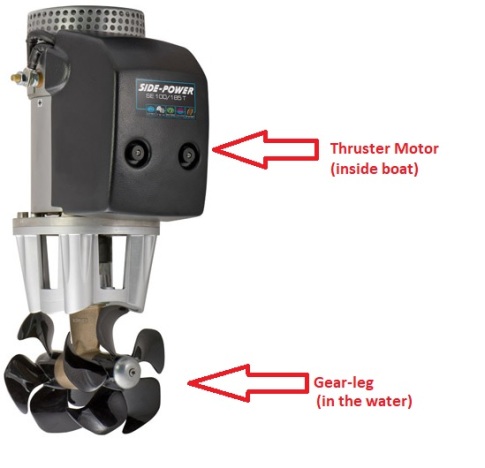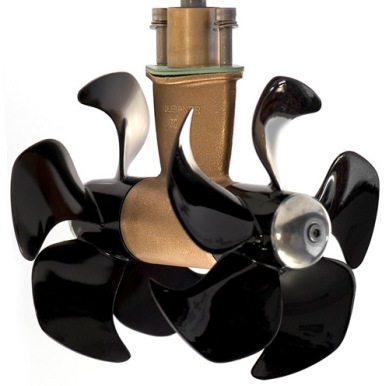Each year since the early 1990s, more and more boats are built with bow & stern thrusters, boat owners without them are installing them to make their boats more maneuverable. Because of this, marine vessels are becoming less dependent on tugboats or experienced crews. While thrusters are extremely helpful for docking and navigating in close quarters, they are often “out of sight, out of mind.” Because their thrusters are often buried deep in the bilge, many boaters don’t even know how to access them for maintenance or repairs.
As a result, very few boaters perform any annual maintenance on their thrusters, aside from changing anodes each season. Like any other piece of equipment on your boat, thrusters require maintenance to operate at peak performance, and you don’t want your thrusters failing at the worst possible time.
800x250.jpg)
That’s why we’ve put together five helpful tips for maintaining your thrusters and keep them running strong. Keep in mind, not all thrusters are the same, so it’s always best to consult your owner’s manual for tips specific to your brand and model of thruster.

1. Replace the Anodes
While almost every marine enthusiast knows to replace anodes, this tip is still at the top of our list because it is the most important. An underwater thruster gear-leg with no anodes to protect it from corrosion will erode in a matter of days and can be dangerous to you and other boaters.
Anodes should be replaced yearly or when they are half-eroded. Prior to launch, use a wire brush to clean lightly eroded anodes and remove any oxidation after being exposed to air. When installing anodes, use blue Loctite, an instant adhesive, on the anode screw.
2. Cleaning & Anti-Fouling
Any time the boat is out of the water, you should remove the props and scrape all marine growth off the gear-leg and propellers. Be very thorough in removing growth, as even barnacle feet left on the props will reduce performance and run time.
Be sure to grease the propeller-shaft with marine-grade grease before re-installing the propellers. The tunnel, gear-leg and propellers should also be painted with anti-fouling paint as the hull requires.

3. Check Operating Voltage
It is always important to make sure the batteries for your thruster are providing enough power. To ensure they are, it’s best to check the operating voltage. It is important to note that this check should only be conducted with the boat in the water, as running the thruster out of the water with no resistance will damage the motor.
“Operating voltage” is refers to the voltage reading after the thruster has been running for approximately 10 seconds. To check it, you will simply connect a volt-meter to the positive and negative terminals on the thruster motor. It’s usually easiest to perform this check with two people: one to operate the thruster from the helm, and the other to hold the volt-meter.
12-Volt thrusters typically run between 9.5V and 10.5V, while 24-Volt thrusters typically run between 18V and 21V. If the voltage is below 9V for 12-Volt thrusters or below 17V for 24-Volt thrusters, you have a low-voltage situation on the boat. Operating the thruster at low voltage will damage components on the motor, such as the solenoid. If that is the case on your boat, a qualified marine technician should look into the cause of low operating voltage.
4. Check Gear-leg Oil (If Applicable)
Some older-models of thrusters require an oil bottle and tube to feed oil into the gear-leg. If you do not have an oil-fed gear-leg, you likely have one that is pre-filled and sealed at the factory and can skip this step.
Check the gear-leg oil feed tube for water. If the oil is milky, there is likely a water leak and the gear-leg should be serviced by a qualified marine technician.
Check the gear-leg oil reservoir level. If more bow thruster oil is needed, consult the owner’s manual and add the proper type of gear oil recommended by the manufacturer. In most cases, an 80-90 or 85-90 weight gear oil will work.
The gear-leg oil should be changed every two years under normal recreational use conditions. To change, remove the drain plug and allow fresh oil from the reservoir to flush out the used oil. Reinstall a new drain plug and gasket and top-off the reservoir as necessary.
Permanently sealed gear-legs do not require servicing.
5. Inspect Thruster Compartment
Beyond inspecting the thruster itself, be sure to examine the compartment in which the thruster motor is mounted as well. The thruster motor creates heat with prolonged usage. It is important that there are no objects in contact with the motor.
Is the thruster compartment dry? If not, make sure to dry it and find the source of the water. The less moisture the better, so do not store any wet or damp items near the thruster motor. Look out for any marine growth inside the tunnel or on the propellers, this can lead to noisy bow thrusters.
Thruster motors can also create carbon dust, so if there is a thin black film or dust in the compartment, that’s perfectly normal, but you may want to wipe it up. You may also want to remove the motor cap and use a vacuum or compressed air to remove the excess dust that has collected in the motor itself. Please note carbon dust is harmful to breathe, so always wear a mask when vacuuming or blowing out the motor.
Lastly, check all the electrical connections and make sure they are tight and free of corrosion.
Following these tips annually will help ensure your thruster runs at peak performance all season long. Be sure to consult your owner’s manual for any maintenance specific to the make and model of the thruster on your boat.
For more information on thrusters, be sure to check out 5 Common Questions About Proportional Speed Control Bow & Stern Thrusters or Which Bow Thruster Type is Best? Tunnel vs. External vs. Retractable vs. Water Jets in Imtra’s Learning Center.